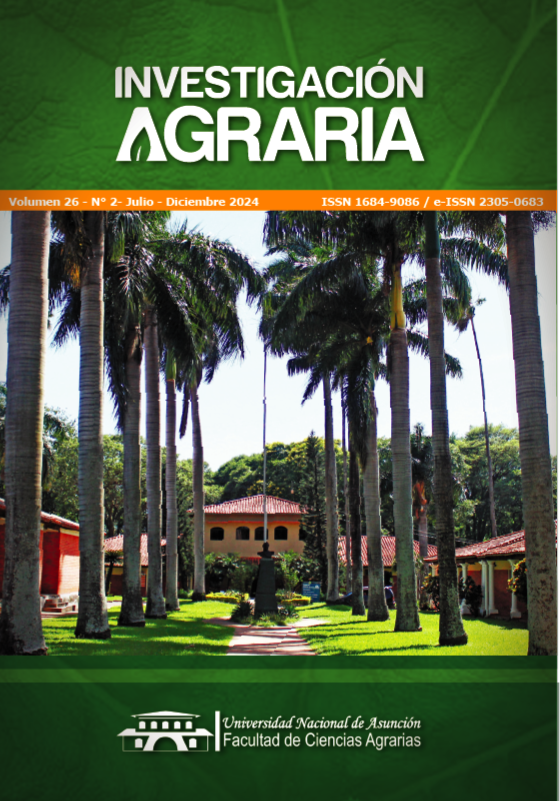Efecto del recubrimiento de papaya (Carica papaya L.) con biofilm de almidón de mandioca en la etapa poscosecha
DOI:
https://doi.org/10.18004/investig.agr.2024.diciembre.2602760Palabras clave:
biofilms, calidad poscosecha, almidón de mandioca, conservaciónResumen
El objetivo de esta investigación fue determinar el efecto del almidón de mandioca como recubrimiento (biofilm) en la conservación y calidad del fruto de la papaya cv. “Maradol” durante la etapa poscosecha. Se evaluó la reducción de la actividad metabólica, la pérdida de agua y el aumento del período de comercialización. Se empleó un arreglo factorial 4 x 4 en un diseño completamente al azar, con 4 concentraciones (0, 1, 2 y 3% m/v de almidón en 100 mL de agua, gelatinizado a 75ºC durante 30 min) y 4 tiempos de evaluación (4, 8, 12 y 16 días poscosecha).Se evaluaron las propiedades físico-químicas: pérdida de masa fresca, apariencia externa, índice de color de la cáscara, pH, sólidos solubles y acidez titulable. A los 16 días, todos los frutos con recubrimiento presentaron una pérdida de masa fresca de 1,9 a 2,6 veces menor que el control, y un color amarillo en 25 a 50% de la superficie de la cáscara, en comparación con 50 a 75% en los controles.El pH disminuyó conforme aumentó la acidez titulable, y se observaron menores niveles de sólidos solubles que en los frutos control durante todo el período. Losresultados demostraron que el uso de la biopelícula fue efectivo, destacándose la concentración del 3% como alternativa para la conservación, al incrementarel tiempo de vida útil durante los 16 días poscosecha, con estadios de madurez inferiores al control y mejor apariencia externa.Descargas
Métricas
Citas
Aghdam, M. S., Sevillano, L., Flores, F. B., & Bodbodak, S. (2013). Heat shock proteins as biochemical markers for postharvest chilling stress in fruits and vegetables. Scientia Horticulturae, 160, 54-64.
Barros, W. K. F. C., de Castro Carvalho, F. L., Barbosa Júnior, L. B., De Sosusa, R. R. , Cardoso Veras, F. H., Da Silva Sousa, P. H., e De Souza Lobo, R. F. (2019). Utilização De Revestimentos Alternativos Na Conservação Pós-Colheita De Mamão ‘Sunrise Solo’. Agri-Environmental Sciences, 5.
Carvalho, A. V., é Lima, L. C. O. de (2000). Modificações de componentes da parede celular e enzimas de kiwis minimamente processados submetidos ao tratamento com ácido ascórbico, ácido cítrico e CaCL2. Revista Brasileira de Fruticultura, 22(3), 386-390.
Carvalho, C. D., Kist, B. B., Santos, C. D., Treichel, M., é Filter, C. F. (2017). Anuário brasileiro da fruticultura. Santa Cruz do Sul: Editora Gazeta Santa Cruz. 88 p.
Castricini, A. (2009) Aplicação de revestimentos comestíveis para conservação de mamões (Carica papaya L.) Golden. (2009) (Tese Doutorado em Fitotecnia) Instituto de Agronomia Universidade Federal Rural do Rio de Janeiro, Seropédica. https://tede.ufrrj.br/jspui/handle/tede/555
Fernandes Chitarra, M. I. e Bosco Chitarra, A. (2005). Póscolheita de frutas e hortaliças: fisiologia e manuseio (Vol. 1). Lavras: Universidade Federal de Lavras (UFLA).
López Enríquez, D. F., Cuatin Ruano, L. Y., Andrade, J. C., y Osorio Mora, O. (2016). Evaluación de un recubrimiento comestible a base de proteínas de lactosuero y cera de abeja sobre la calidad fisicoquímica de uchuva (Physalis peruviana L.). Acta agronómica, 65(4), 326-333.
Ferreguetti, G. (2006). Produção de mamão para o mercado externo e interno. Campo Grande: Caliman Agrícola SA.
Hewajulige, I. G. N., Sivakumar, D., Sultanbawa, Y. & Wijesundara, R. L. C. (2006). Effect of chitosan coating of postharvest life of Papaya (Carica papaya L.) var Rathna grown in Sri Lanka. Tropical Agricultural Research, 18.
Instituto Adolfo Lutz (I.A.L.) (2008). Métodos físicoquímicos para análise de alimentos. Secretaria de Estado da Saúde, Instituto Adolfo Lutz
Kathiresan, S., & Lasekan, O. (2019). Effects of glycerol and stearic acid on the performance of chickpea starchbased coatings applied to fresh-cut papaya. CyTAJournal of Food, 17(1), 365-374.
Nunes, A. C. D., Neto, A. F., Nascimento, I. K., de Oliveira, F. J., & Mesquita, R. V. C. (2017). Armazenamento de amão’formosa’revestido à base de fécula de mandioca. Revista de Ciências Agrárias, 40(1), 254-263.
Oliveira, T. A. (2014). Desenvolvimento de filmes à base de fécula de mandioca e aditivos naturais e sua aplicação na conservação de mamão (Doctoral dissertation, Tese (Mestrado)–Universidade Federal Rural do Semi-Árido, Mossoró, RN, 111f).
Pego, J., Ambrósio, M., Nascimento, D., Fachi, L. R., e Krause, W. (2015). Conservação pós-colheita de mamão ‘sunrise solo’com revestimento comestível a base de fécula de mandioca. Enciclopédia Biosfera, 11(21).
Perdones, A., Sánchez-González, L., Chiralt, A., & Vargas, M. (2012). Effect of chitosan–lemon essential oil coatings on storage-keeping quality of strawberry. Postharvest biology and technology, 70, 32-41.
Pereira, M. E. C., Silva, A. S. D., Bispo, A. S. D. R., Santos, D. B. D., Santos, S. B. D., e Santos, V. J. D. (2006). Amadurecimento de mamão formosa com revestimento comestível à base de fécula de mandioca. Ciência e Agrotecnologia, 30, 1116-1119.
Sasaki, F. F. C., Pereira, M. E. C., de Morais, P. L. D., de Almeida, G. V. B., Terao, D., Oster, A. H., e Cerqueira, T. S. (2018). Manejo pós-colheita e desenvolvimento de tecnologias para aplicação em pós-colheita para redução do uso de agrotóxicas em mamão. Simpósio
do papaya brasileiro, Vitória. ES.
Zucchini, N. M., Miranda, M., Bresolin, J., Foschini, M. e Ferreira, M.(2017). Avaliação do potencial de coberturas nanoestruturadas de cera de carnaúba na conservação pós-colheita de mamão. En Anais da 9ª Jornada Científica Embrapa São Carlos, 26 e 27
de Outubro de 2017. São Carlos: Embrapa Pecuária Sudeste e Embrapa Instrumentação
Descargas
Publicado
Cómo citar
Número
Sección
Licencia
Derechos de autor 2025 Manuel Rodríguez González, Mailen Abreu Rodríguez , Nerelys Cabrera Julien, Daisy Deniz Jiménez

Esta obra está bajo una licencia internacional Creative Commons Atribución 4.0.
Todo el contenido de esta revista, está bajo Licencia de Atribución Creative Commons.









 Todo el contenido de esta revista, está bajo
Todo el contenido de esta revista, está bajo 